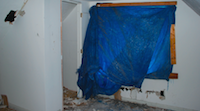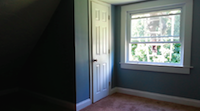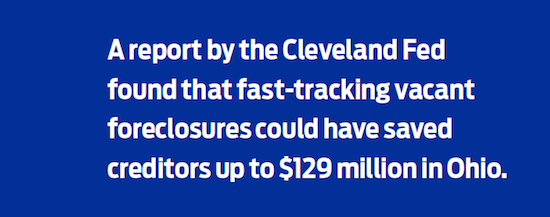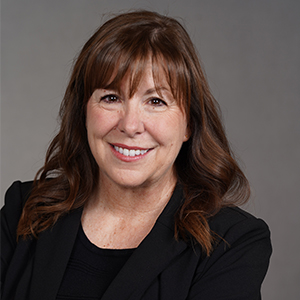One of the nation’s enduring scars from the foreclosure crisis is community blight — the degradation of whole neighborhoods due to vacant houses boarded with plywood. Just one house in this condition can create a snowball effect, depressing housing values and ultimately leading to more vacant homes. In the worst years of the financial crisis, the rapid pace of foreclosures in some areas triggered an avalanche of vacant, vandalized houses that trapped homeowners in decaying neighborhoods with no way out.
Robert Klein had a front-row seat to this unfolding drama. He was CEO of the largest mortgage field services company in the nation during the crisis, Safeguard Properties, and saw the damage first hand. As part of its mandate to secure client assets, Safeguard boarded properties with plywood just like every other field services company. But the resulting devastation disturbed Klein, and his desire to find a solution to community blight became a passion, then an obsession.
In 2010, Klein handed the CEO duties of Safeguard to Alan Jaffa, and began to tackle the problem of blighted areas in earnest, founding Community Blight Solutions. Klein knew that any strategy had to address a bank’s need to secure its assets without disrupting the stability of the neighborhood in the time it took to foreclose. Klein found part of the answer in SecureView, a clear-boarding product he helped create with real estate developer Howard Wedren.
SecureView looks just like the normal glass in windows, but is virtually indestructible: The patented industrial-grade sheet material is 200 times stronger than traditional glass. It uses an interior clamping system that makes it easy to install without damaging the property or advertising that the house is vacant. With SecureView, neighborhood property values aren’t diminished by houses that look abandoned, which stems the number of further foreclosures.
Klein was ecstatic with SecureView, but it was only one part of a larger strategy in his war against community blight. He began looking for an area where he could work with local leaders to transform an entire neighborhood that was down and out, developing a blueprint that other servicers could follow.
It turned out he didn’t need to look very far from his company’s headquarters in central Ohio.
SLAVIC VILLAGE
If you wanted to stick a pin on a map of the U.S. for ground zero of the foreclosure crisis, Cleveland’s Slavic Village neighborhood might be it. The working-class area south of downtown was identified in 2007 by CNN as the worst neighborhood in the nation for foreclosures, with 800 houses vacated in a short amount of time. The crime that followed the vacancies devalued other houses in the area until selling became a virtual impossibility. Homes valued at around $150,000 before the crisis would be appraised at just $20,000 a few years later.
In November 2007, CNN Money reporter Les Christie wrote, “The first thing that happened after owners moved out of foreclosed homes in Slavic Village was that squatters and looters moved in,” according to Mark Wiseman, director of the Cuyahoga County Foreclosure Prevention Program. ‘In the inner city, it takes about 72 hours for a house to be looted after it is vacant.’
The vacant houses and empty lots became a base of operations for gangs and drug dealers, leading to frequent thefts, muggings and the deaths of five innocent residents in the next two years in what had been a quiet neighborhood.
 But the Slavic Village community was not going to just give up. The area had once been home to more than 70,000 residents, many of which were descendants of the original Polish immigrants who settled the area, but now had dwindled to about 25,000 residents.
But the Slavic Village community was not going to just give up. The area had once been home to more than 70,000 residents, many of which were descendants of the original Polish immigrants who settled the area, but now had dwindled to about 25,000 residents.
 Several strong community groups formed in the midst of the crisis, helping residents get loan workouts from lenders and organizing crime watches. These groups included nonprofit organizations Neighborhood Progress Inc. and Slavic Village Development. It was this local commitment that made Slavic Village a prime candidate for Klein’s vision.
Several strong community groups formed in the midst of the crisis, helping residents get loan workouts from lenders and organizing crime watches. These groups included nonprofit organizations Neighborhood Progress Inc. and Slavic Village Development. It was this local commitment that made Slavic Village a prime candidate for Klein’s vision.
“The biggest problem in our industry (servicing) has been a lack of communication with communities around the country,” Klein said. “We have the same exact goal — to stop blight. Servicers want to maintain their collateral interest, and communities want to maintain the property for different reasons, so how do we put these goals together?”
The eventual partnership included the two local nonprofits, Klein and a developer, Forest City Enterprises, which had deep roots in the neighborhood. This coalition met for more than two years to iron out the details of what would become Slavic Village Recovery LLC, a private, for-profit company set on revamping the entire neighborhood block by block. The for-profit part was surprising to some, but something that Klein points to as absolutely essential for the plan’s success.
“I basically insisted that this be a for-profit entity and that we would run it like a business,” Klein said.
Slavic Village Recovery’s first move was to survey all of the 2,200 homes in the neighborhood, which the nonprofit groups estimated to be 25% to 30% vacant. The company researched titles and loans and even went door-to-door to find out which houses were occupied, which were in foreclosure and what if any rehab efforts had been done.
Having a servicing company involved at this stage was critical, according to Cleveland City Councilman Tony Brancatelli, a life-long Slavic Village resident and an integral part of the coalition.
“Setting up systems for managing distressed and vacant properties is a unique skill set,” Brancatelli said. “Turning rehabbed houses on a regular basis is one thing, but dealing with bringing these large numbers of distressed properties into the system is a whole different thing.”
With a clear picture in hand, Slavic Village Recovery started removing the plywood boards and putting up SecureView one street at a time. The effect was instantaneous.
“When the community saw that we were removing plywood for SecureView, they knew we were serious about this,” Klein said. “It changed the mentality and we really got the entire community to work with us.”
It also made the neighborhood safer almost immediately, as properties were really secured for the first time and police were able to see inside the residences. First responders were no longer afraid to answer calls from the neighborhood and residents felt more empowered than ever.
“You can’t have a boarded property next to a property you’re rehabbing, so we would even put it up on houses we didn’t own yet that were abandoned,” Brancatelli said. “With SecureView, you can keep the product on throughout the entire renovation and it makes the rehab easier and safer.”
The next step in the recovery project was to bring in a staff of people to work out individual loans. If a house was in foreclosure, the recovery team called the servicer to get a loan modification, or to buy the house outright. These properties, worth less than $20,000 and full of code violations and safety issues, were liabilities for servicers. Some servicers sold them to Slavic Village Recovery and some donated them to the CuyahogaLand Bank, which then gave it to Slavic Village Recovery.
If the property was vacant and abandoned, the recovery team worked with residents to track down the title holders they knew. The team discovered that most of these former residents still lived within a 20-mile radius of the abandoned homes in order to keep their kids in the same schools, and current residents were often able to contact them. Most were happy to sign over their deeds.
The recovery team then set up a triage system to determine which properties needed to be demolished and which could be rehabbed.
 REFUSING PUBLIC MONEY
REFUSING PUBLIC MONEY
One of the company’s most strategic decisions was its commitment to use private money to do the repairs.
“When we met with city officials and told them what we were planning and said, ‘By the way, we don’t want any subsidies,’ their heads shot up,” Klein said.
Using public money in Cleveland would entail meeting LEED standards that would drive up rehab costs and in the end make the houses too expensive for residents to afford. And lenders would balk at financing these more expensive homes when neighborhood values were still depressed.
Instead, Klein met city building code standards that ensured safety but still kept the homes affordable.
“The beauty of our approach was that we were able to rehab properties for about $45,000 to FHA quality, which includes a new roof, new siding and a new boiler. Now those homes are selling for about $60,000, which means the monthly payment on a 30-year mortgage is about $495. Rent in Slavic Village was over $800, so we also created affordable housing.”
Houses that have been rehabbed in the Recovery project are now being sold as quickly as they are completed, and the profit on each house goes right into rehabbing the next one. In the past two years the company has rehabbed and sold 58 homes, and has plans to do 200 more. The difference these rehabbed homes make to the whole community has been stunning.
“Today the property values in Slavic Village are going up and people don’t want to sell and move out anymore. It’s that kind of revitalization that we’re seeing in Slavic Village. It’s a model that’s really working,” Klein said.
Brancatelli agreed. “All of these changes have given the community a sense of hope and pride, and helped to move the needle on other enterprises.” Those new businesses include new steel mills, restaurants, a golf course and even a velodrome.
“People are looking at the neighborhood differently now,” Brancatelli said.
THE BIGGER PICTURE
Klein’s vision is being played out in Slavic Village, but he is eager to see blight addressed nationwide.
“Everything in our industry right now is reactive. As servicers, when a property is vacant and damaged, you try to get it in reconveyance condition. But if you put on a plywood board you have already caused the damage. We need to find a mechanism that is proactive.”
One of those mechanisms is getting regulations changed at the local level, where cities can mandate that companies use clear boarding to secure a vacant property instead of plywood. Klein has worked with local leaders around the country to demonstrate the difference clear boarding can make, and last May, Phoenix became one of the first major cities to pass an ordinance that banned plywood on vacant REOs.
 Although using clear boarding is more expensive than plywood initially, Klein believes it saves money in the end since a typical plywood board has to be replaced three times because of damage from vandalism and weather-related events.
Although using clear boarding is more expensive than plywood initially, Klein believes it saves money in the end since a typical plywood board has to be replaced three times because of damage from vandalism and weather-related events.
And that’s just the cost of the board — the damage to the house might be much more. Homes in Slavic Village that were broken into were stripped of siding, appliances and finally, copper piping, which is usually acquired by taking a sledgehammer to the walls.
“If you put up clear boarding in the presale stage of the foreclosure process, you could save millions of dollars in damages to those properties and you also save other homes in that neighborhood from being devalued. We continue to work to pass local ordinances to ban plywood boarding for this very reason,” Klein said in a HousingWire interview in November 2015.
Another strategy is to tackle foreclosure timelines at the state level. Foreclosures in non-judicial states are bad enough, but in judicial states they take years to work out — averaging 620 days in the first quarter of 2015. In places like New York and New Jersey, the averages were more than 1,000 days. Fast-tracking those foreclosures would change the tide in places that are still buried under zombie properties.
Brancatelli sees faster timelines as a way to spare other communities the pain that Slavic Village had to endure.
“Time is not on the community’s side in these situations,” Brancatelli said. “To wait the laboriously long time it takes for a standard judicial sale — by then the property loses so much value we have seen mortgage companies walk away or see their asset disintegrate to nothing.”
A report by the Cleveland Fed in 2013 found that fast-tracking of vacant foreclosures could have saved creditors $24 million to $129 million in Ohio and $24.3 million to $54 million in Pennsylvania. Five states, including Illinois, Maine, Nevada, New Jersey and South Carolina, have enacted fast-track legislation and five more have bills under consideration. In Ohio, HB 134, which would reduce foreclosure to six months once a property is abandoned, passed 88-0 out of the House and looks likely to pass in the Senate.
Solving the problem of community blight requires a concerted effort on many different fronts. But the innovative partnership in Slavic Village demonstrates how servicers can be a vital part of the solution in neighborhoods across the country and, in the process, generate momentum for an even larger recovery.







